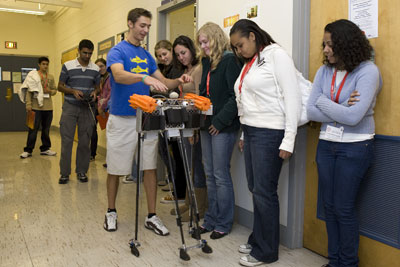Engineering college on track to exceed diversity goals for women, minorities
By Anne Ju

This year's freshman class in the College of Engineering is 37 percent female, putting the college on track to surpass a goal set five years ago to further diversify the college's traditionally male-dominated population.
For the first time since unveiling its 10-year strategic plan under former dean Kent Fuchs, the college has reached a major diversity milestone by achieving at least 35 percent women in an undergraduate class. The strategic plan outlines the goal of a 35 percent female undergraduate population by 2015. Along with last year's freshman class, which was 34 percent female, this year's class has boosted the total current female population to 31 percent, putting the goal squarely within reach.
"It's really taken off over the last few years," said Mark Spencer, director of engineering admissions. "This particular year was a big jump for us."
The number of underrepresented minority students has also seen a significant increase, with 12 percent of the Class of 2013 fitting that category. That number outpaces the goal laid out in the strategic plan of 10 percent for the total undergraduate population by 2015. Currently, minorities make up 8 percent of undergraduate enrollment in engineering.
"We were excited but not overly surprised," said Sara Xayarath Hernandez, interim director of Cornell's Diversity Programs in Engineering (DPE) office. "With all the programming and strategic initiatives we have in place, this is a trajectory we had placed ourselves on."
In 2006 women made up 17.2 percent of the nation's undergraduate engineering student population, according to the American Association of Engineering Societies' Engineering Workforce Commission. Underrepresented minorities made up 15.4 percent of the national total.
At Cornell, the 275 women out of a total of 734 freshmen this year is the highest-ever number of female students enrolled in an engineering class year. In the past five years, the number of female applicants to the college has also doubled.
Spencer attributes the trend to many factors, particularly the ever-evolving outreach programs that engineering admissions and DPE run to attract female and minority high school students. These include the annual fall Women in Engineering day, to be held this year Oct. 17, at which high school seniors just starting the college application process spend a day on campus meeting faculty and students, attending lab demonstrations and touring facilities. The event is a collaborative effort between engineering admissions and DPE.
In the spring, admitted students are invited to stay overnight with student hosts. Last spring, 74 percent of the hosted female students, now part of the Class of 2013, chose to attend Cornell. The college runs similar fall and spring programs for prospective and admitted underrepresented minority students.
The DPE office also has many programs to support female and minority students while they are on campus. For example, a program called CU EMPower matches incoming students with upperclassmen for yearlong mentoring, which also includes team-building activities and monthly meetings. Another program, Strategic Action for Excellence, consists of presentations on academic development, such as strategies for picking a major.
Hernandez stressed that student organizations like the Society of Women Engineers, National Society of Black Engineers, Society of Hispanic Professional Engineers and the American Indian Science and Engineering Society are integral components of supporting diversity at the college, both in recruitment and retention.
"The students bring their energy, and they bring their perspective," Hernandez said. "They are the ones volunteering to host visiting students overnight, sitting on panels and doing lab tours. All these things make a huge impact."
Though excited about their progress, officials agree that there's still a long road ahead toward increasing the college's diversity.
"We have programs that work, and we want to keep those, obviously, but it doesn't mean we can't enhance them and try to think of new and different ways to continue recruiting students," Spencer said.
Media Contact
Get Cornell news delivered right to your inbox.
Subscribe